The Overview report provides you with a versatile summary of a domain’s performance. This report covers three main categories: Organic Research, Paid Research, and Backlinks.
Below, you can find descriptions for metrics and widgets of the Overview report.
Settings
Like all other Analytics reports on Semrush, this report can be adjusted by:
- Geographic database (Semrush relies on Google's ways of determining which country, region, or city a user is searching from)
- Device (desktop or mobile devices)
- Date (if you have access to historical data)
You can also use the report to query a URL or subfolder or subdomain that you’re interested in analyzing.
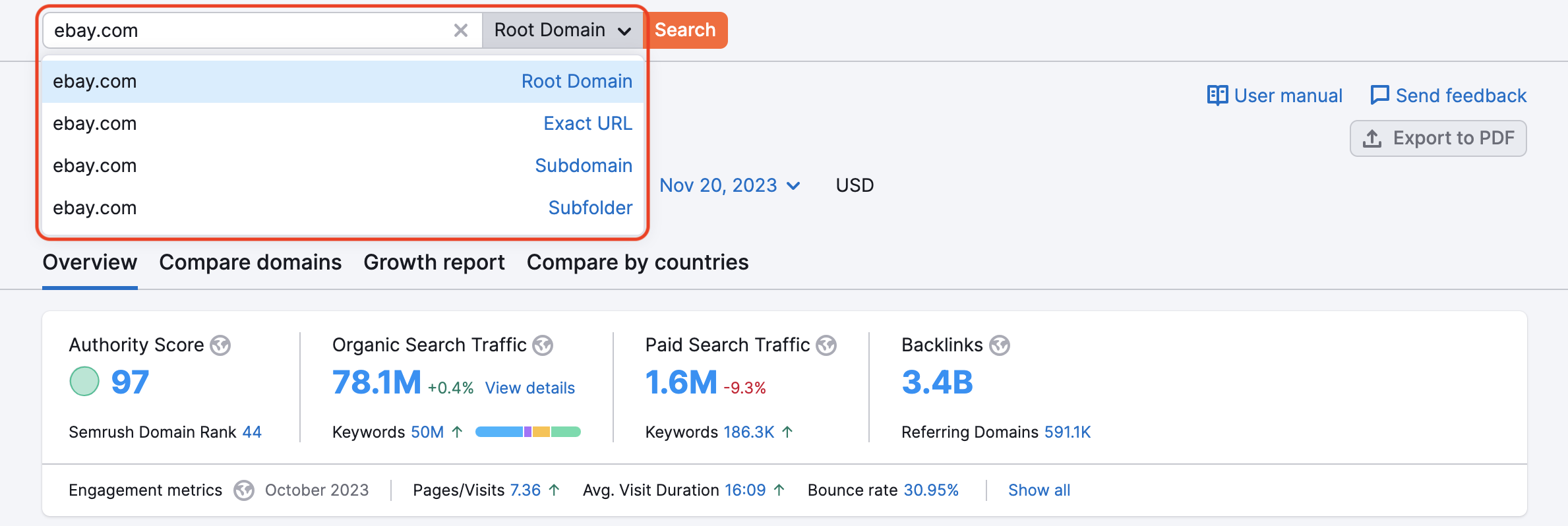
Top Metrics
The five main overview metrics at the top of Domain Overview are:
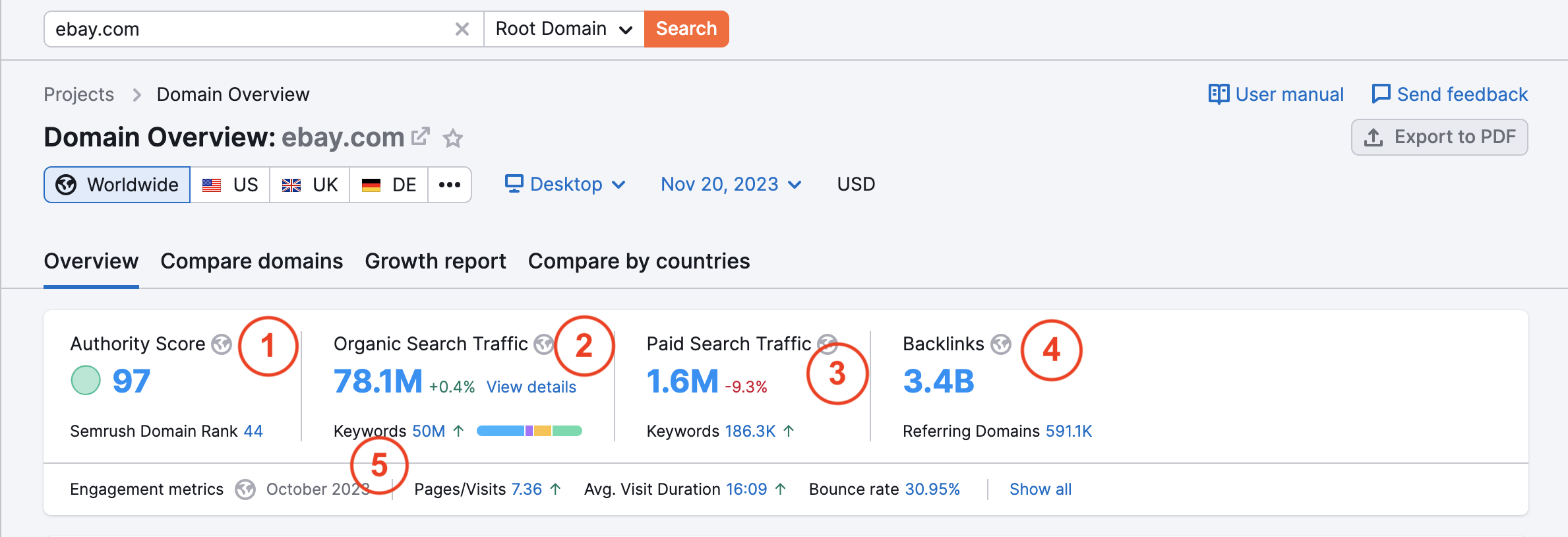
- Authority Score: This estimates how authoritative a site is, how much Google trusts them and how much SEO impact their links have when they send hyperlinks to another site.
Please note: Authority Score can measure a domain and a page but cannot measure a subfolder or subdomain’s authority at this time. If you are researching a subfolder or subdomain, this module will show the authority score of the root domain. - Organic Search: This blue number shows the amount of estimated traffic the domain receives, per month, from organic search. Click on the number to open a more detailed Organic Positions report. This number will adjust if you query a subfolder, subdomain or URL. The “View details” button refers to the percentage number and opens a Position Changes report in Organic Research.
At the bottom, there is a keyword intent distribution bar. It gives you a quick overview of the user intent your competitor is focused on. Hover over the bar or scroll down to the Organic Research section to get insights into which intent drives more organic traffic to their website. - Paid Search: This blue number shows the amount of estimated traffic the domain receives per month from PPC ads. Click on the number to open a more detailed Advertising Positions report. This number will adjust if you query a subfolder, subdomain or URL.
- Backlinks: This blue number shows the total amount of backlinks Semrush found going to the domain. Click on the number to open up more detailed Backlinks reports. This number will adjust if you query a subfolder, subdomain or URL.
- Traffic Engagement Metrics: These are global (not specific to one country) traffic behavior estimates from our Traffic Analytics database. If you don’t see this widget it could be because the website does not have enough monthly traffic to register in our Traffic Analytics database.
Please note: If you are researching a subfolder, subdomain, or URL this module will show the engagement metrics of the root domain.
Keywords by Country and Traffic Trend
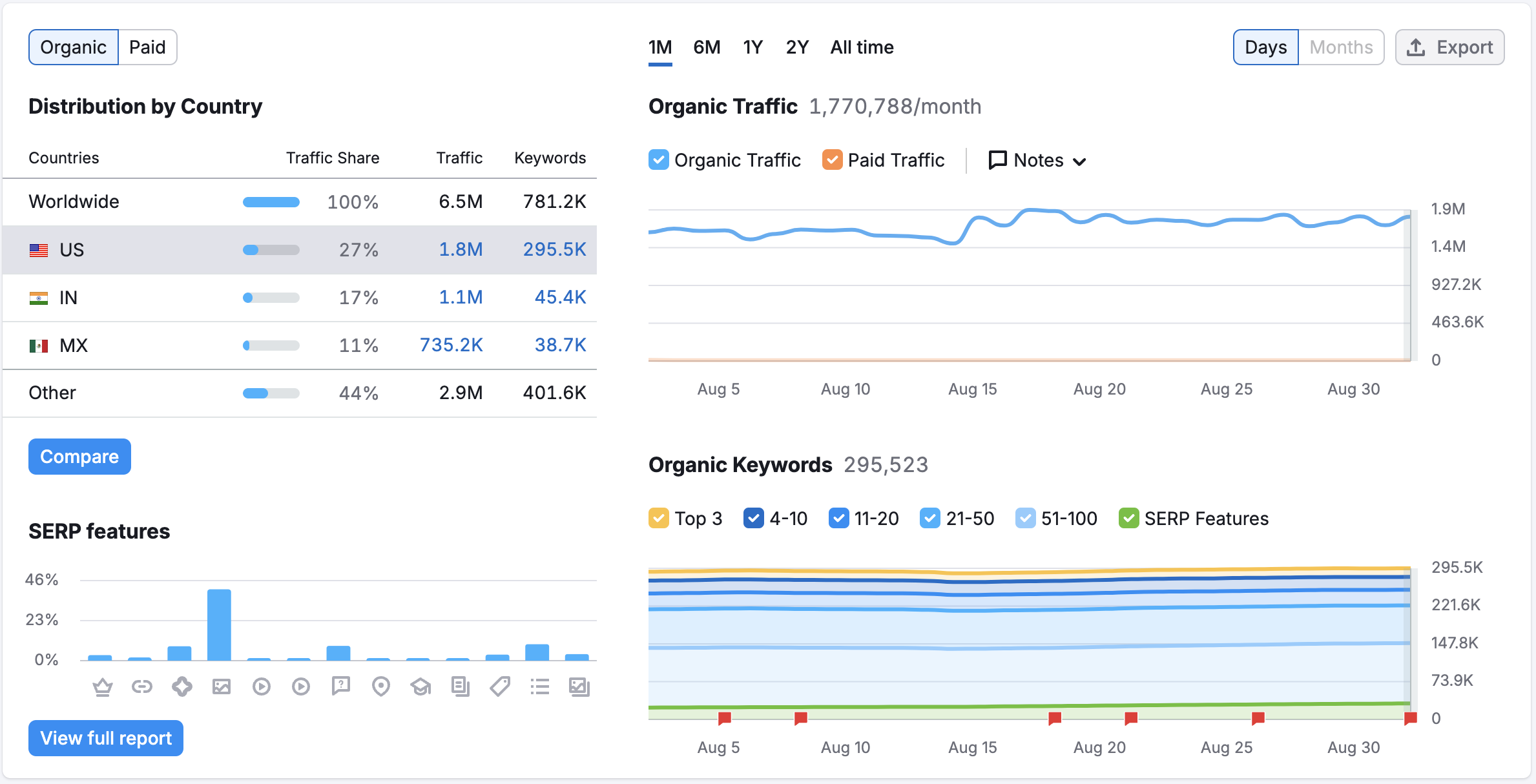
The Distribution by Country widget can show you where most of a domain’s traffic comes from globally - for both organic and paid traffic. This could help you discover where a global competitor has a successful advertising campaign, or organic online presence for example.
Please note that the Distribution by Country widget can only measure on the root domain level.
The Organic Traffic and Keyword graphs tell you how much estimated traffic Semrush saw going to the domain over time. This graph will change when you change the query to a URL, subfolder, or subdomain so you can look into more specific trends in your competitor’s strategy. Depending on the selected time period, you can switch between monthly and daily trend graphs.
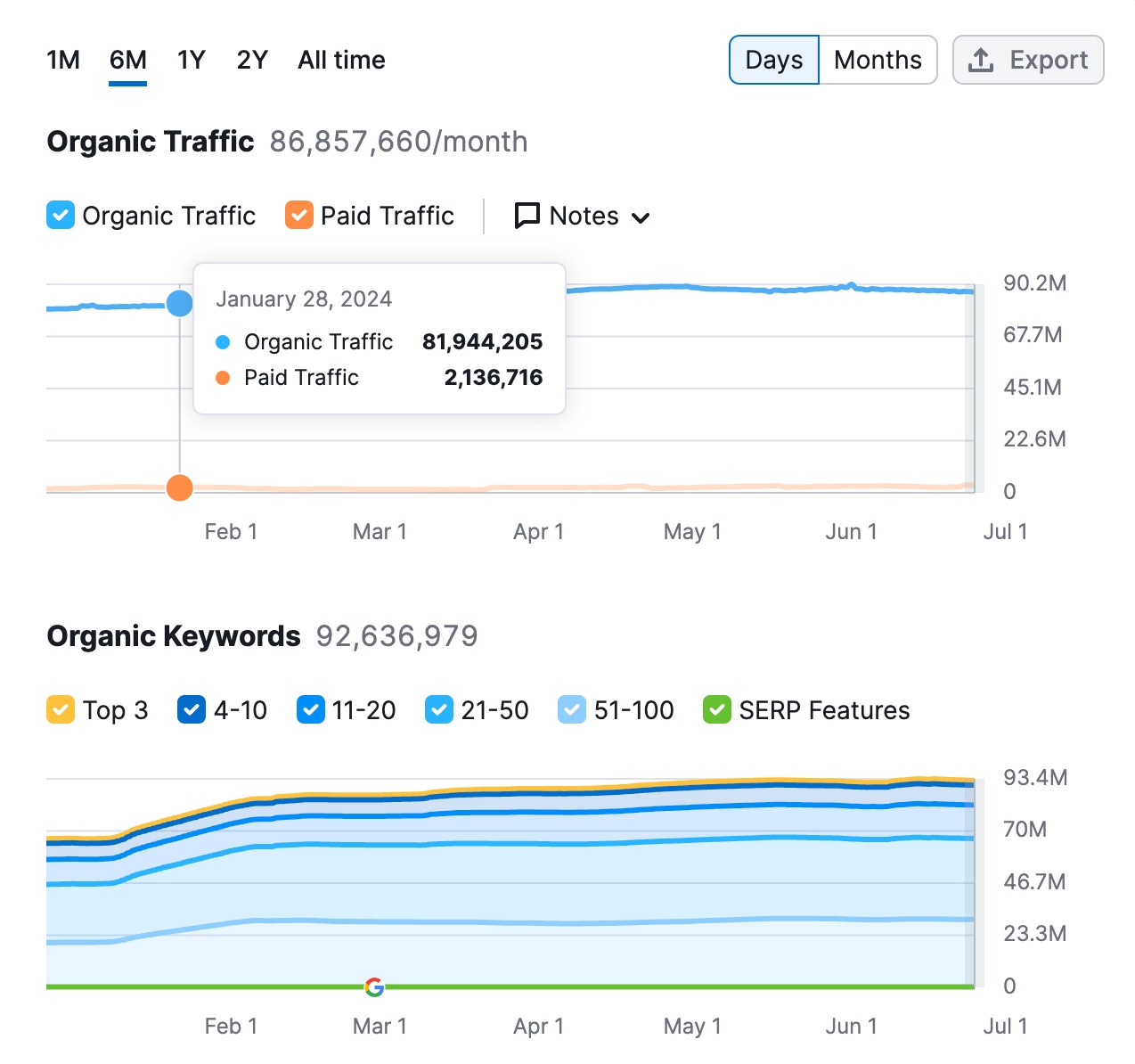
SERP features show the percentage of keywords for which an analyzed domain ranks in each SERP feature. If you hover over the bars on the graph, you’ll see how many of the domain’s keywords trigger a certain SERP Features and how many among them link to the analyzed website.
Organic Search
The first part of the Domain Overview covers everything about a domain’s organic traffic. This ranges from top organic keywords to competitors and branded search traffic. If you are researching a URL, subfolder, or subdomain, all of these widgets will adjust to show specific data and trends of that scope.
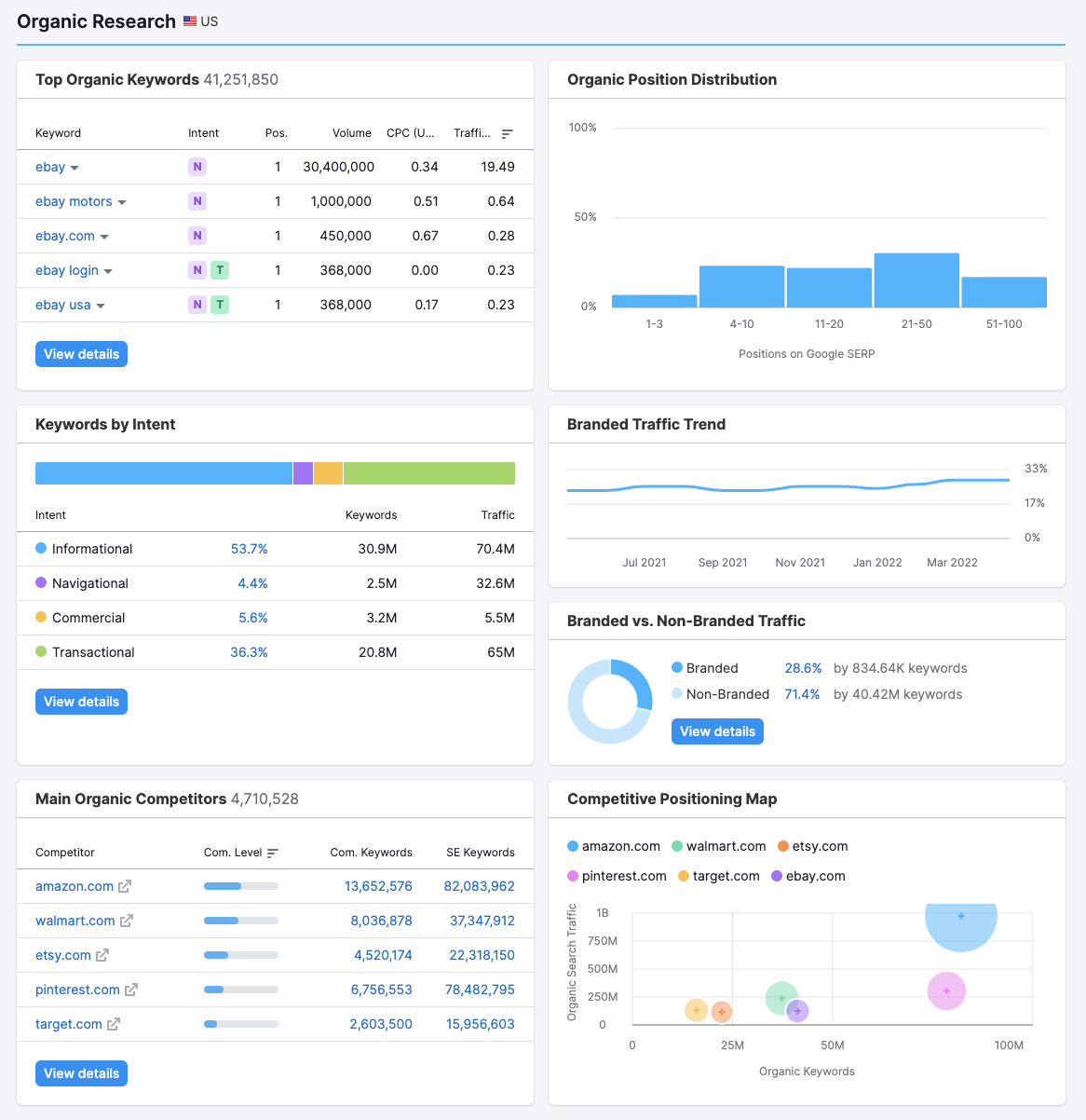
- Top Organic Keywords - This lists the domain’s top five organic keywords in order of their traffic percentage. You can also see the keyword intent, position, volume, and CPC.Hover over the icons in the Intent column to see the purpose of a user’s search.
- Organic Position Distribution - This graph shows the distribution of the domain’s organic rankings. You can see how many keywords the domain has rankings for in the top 3 positions, 4-10, 11-20, and so on.
- Keywords by Intent - This graph shows the distribution of the domain’s total number of keywords with organic positions (in Google’s first 100 results) by search intent. The 4 intents are transactional, commercial, informational, and navigational. You can easily get insights about your competitors strategy - which intent prevails and how much traffic it can attract to their website. Click “View details” to open the Organic Positions report and get the list of the domain’s organic keywords with their search intent and landing pages that rank for these terms.
- Branded traffic trend - Branded search traffic is organic traffic coming from keywords that include your brand name. For example, Semrush counts traffic to Amazon.com from keywords like “amazon prime,” “Amazon books, and “amazon smile” as branded search traffic. If one month of the year had a higher density of branded searches, it will be shown here.
- Branded vs non-branded search traffic - This tells you how much of a website’s organic traffic comes from branded vs non-branded search.
- Main Organic Competitors - These competitors are ranked by how similar their keyword portfolios are. The number of common keywords and total SE (search engine) keywords are listed in the table. Click “view details” to open the Organic Competitors report and get the full list of the domain’s organic search competitors.
- Competitive Positioning Map (organic) - The map illustrates the spread of a domain’s competitors based on the number of organic keywords and search traffic.
Paid Search
The second section of the Domain Overview has previews of all the reports related to paid search. Again, if you are researching a URL, subfolder, or subdomain, these widgets will adjust to show specific data and trends of that scope.

- Top Paid Keywords - The domain’s top five paid keywords will be shown here, ranked in order of their traffic percentage. Traffic percentage represents the number of people that visit the website from clicking on an ad after searching that keyword. Click on “View details” to open an Advertising Positions report. This report can show you all of the top keywords your competitor bids on to bring traffic to their website.
- Paid Position Distribution - This chart shows the distribution of the domain’s positions for paid keywords. The more positions a domain has in the top 3, the more optimized their PPC efforts are.
- Main Paid Competitors - Shows a domain’s top five paid search competitors. This list is based on the number of keywords for each domain, as well as the number of common paid keywords between both competitors.
Click on a number in the Common Keywords column to see the full list in a Domain vs Domain report. Click on a number in the Ads Keywords Column to open an Advertising Positions report for that competitor. Or, click on “View details” to open an Advertising Competitors report for your queried domain. - Competitive Positioning Map (paid) - This illustrates the spread of a domain’s competitors based on the number of paid keywords and search traffic. The larger the circle, the more visibility a domain has across paid keywords.
- Sample Text Ads - This section shows samples of the domain’s PPC ads as they appeared in the results. Click on any ad to go to the landing page. You can also click on “View details” to open an Ad Copies report. There you can see all of the ads that Semrush found the domain bidding on during the last month.
Backlinks
The third part of the Domain Overview provides data on aspects of the domain’s backlink profile. This includes the total number of backlinks, ratio between follow and nofollow links, and top referring domains. Just like the Organic Search and Paid Search widgets, these widgets will adjust if you want to research a subfolder, subdomain, or URL.
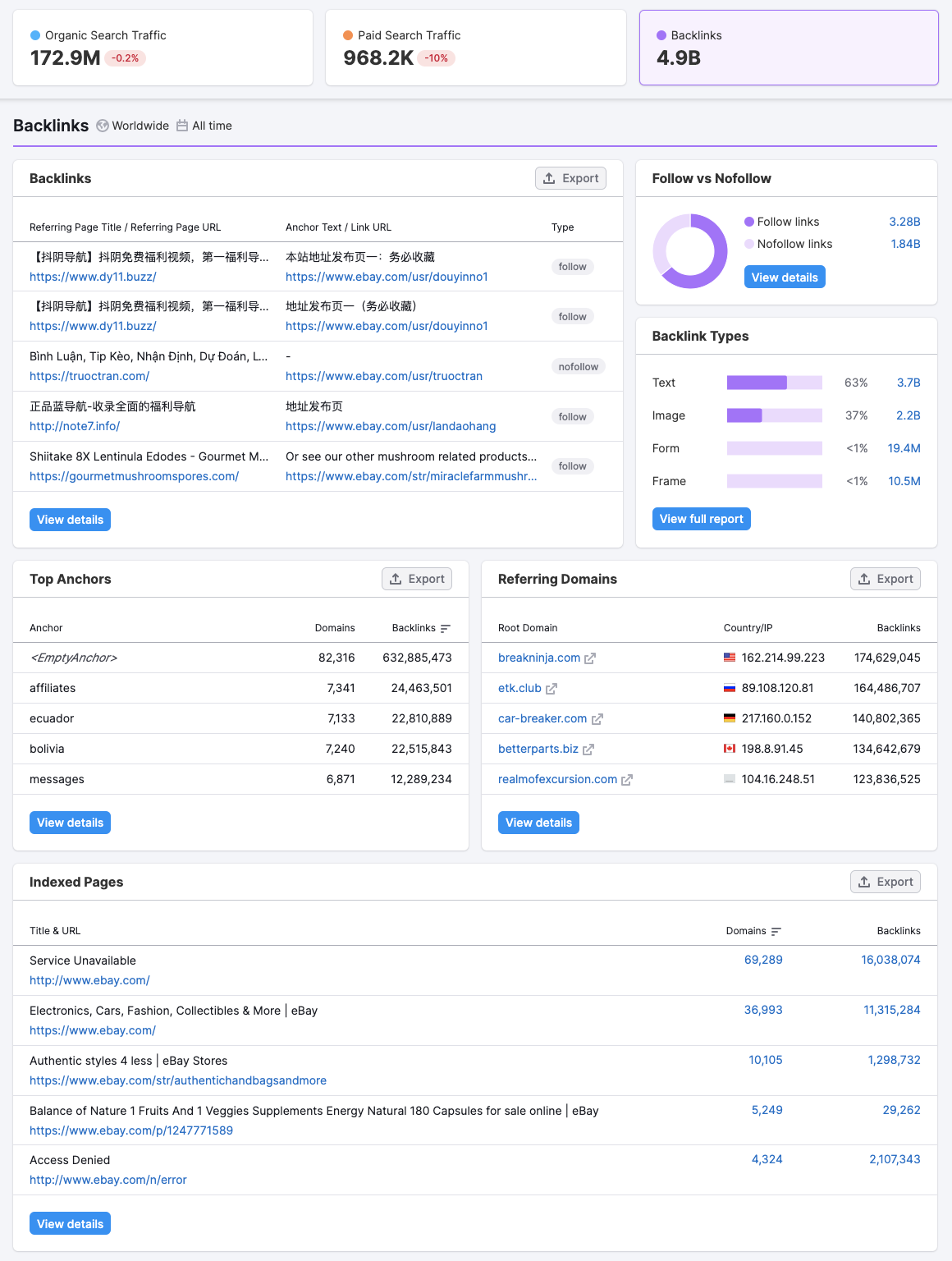
- Backlinks - The first module in this section shows a preview of the domain’s backlink profile. Click “View details” to open up the entire list in the Backlinks report. From there you can evaluate the domain’s backlinks by metrics like Page Authority Score and number of internal/external links on the referring pages.
- Follow vs. Nofollow- This chart shows you the ratio of follow vs nofollow links. A “nofollow” link has a special HTML attribute that instructs search engine bots not to count this link towards influencing the target website’s authority and rankings. Meanwhile, a “follow” link just means a normal hyperlink without the “nofollow” attribute. These hyperlinks can benefit the target website’s SEO, while those with a “nofollow” attribute will have no additional SEO impact.
- Backlinks Type - This chart identifies how many links in the site’s backlink profile are text, frame, form, and image links.
- Top Anchors - The top five most common anchor texts in the domain’s backlinks will be listed here. This tells you how other websites refer to the domain when they link to it. It also shows you how many referring domains use each anchor, and how many backlinks use each anchor. Click “View details” to open up the complete list of anchor texts.
- Referring domains - The top referring domains will be listed here in order of how many backlinks they’re sending to the searched domain. Click on any of these domains to go to that domain’s Domain Overview. You can also click “View details” to see the complete list of domains sending backlinks to your queried domain.
- Top indexed pages (by the number of backlinks) - The pages on the domain that have the most backlinks are listed here.
PDF Reporting
You can export data from the Domain Overview Overview report to PDF format or craft a personalized report using the My Reports tool. Integrate information from Domain Overview, Semrush tools, Google Analytics 4, GSC, and additional sources to generate tailored PDF reports. Customize these reports to match your brand identity and set up automatic updates for effortless report automation.
